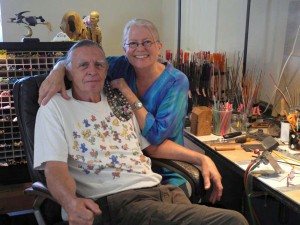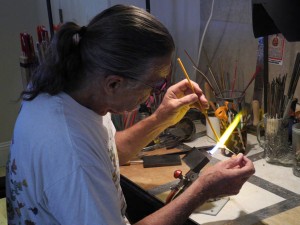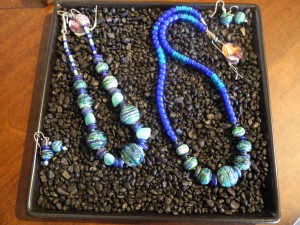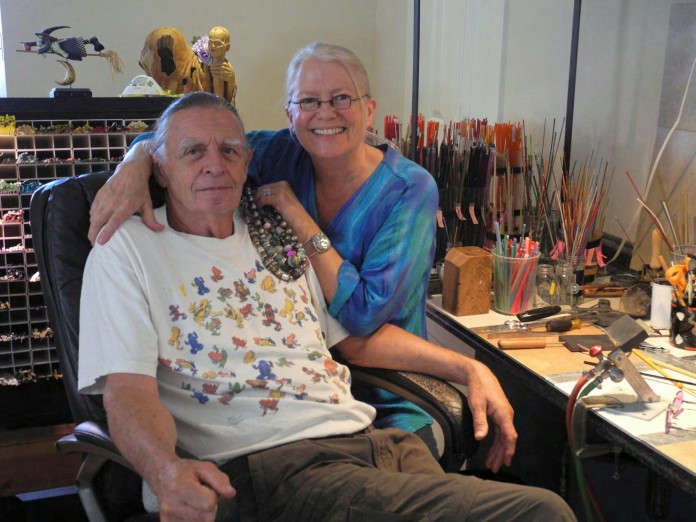By Doris Faltys
 Lampworker Ernie Wagner and his wife, designer Darcie Richardson, have been making glass bead creations for about 12 years.
Lampworker Ernie Wagner and his wife, designer Darcie Richardson, have been making glass bead creations for about 12 years.
“Many people think we are blowing glass or fusing glass,” Ernie explains. “What I am doing is lampwork – basically melting glass. As early as the 1500s, people were making beads by melting glass in the flame of their oil lamps. That is where the term lampwork comes from. The Italians and the French used oil lamps with a pump to make huge numbers of beads for the African bead trade. Now people scour Africa looking for those old beads to bring back and sell.”

When asked how he first discovered the craft, Ernie describes his first lampworking experience. “We were visiting a friend who has a business selling glass on eBay. Our friend thought that Darcie would really like bead making and had her sit down to try it out. Well, Darcie sat down and wasn’t too thrilled. But I sat down, made one bead, and got hooked.”
“After that initial introduction,” Darcie adds, “Ernie set up in our garage here in Olympia. He would go out in the garage, in the middle of winter, and work with a blanket over his legs.”
“I am primarily self-taught,” says Ernie. “I watched some tutorials and bought a really good book, Passing the Flame: A Bead Makers Guide to Design and Detail, by Cornia Tettinger.”
Darcie creates jewelry with both beads she has collected and Ernie’s creations. “I had done some work with beads,” Darcie shares. “All of a sudden, I had this bead source!”
They invite me to sit and watch as Ernie creates a bead. “I use a propane tank with an oxygen booster,” he explains as he lights his flame. “This gives a hotter flame, over 1000 degrees.”
Darcie hands me a pair of dark glasses and instructs me to put them on.
‘The glass I work with,” Ernie continues, “has a lot of soda in it, which flares when put into the flame.”
He holds a cane of colored glass into the flame and it does, indeed, begin to flare. “The flare makes it hard to see what you are doing, so I wear dark glasses. Then I can see exactly what I am doing.”

Ernie picks up a small stainless steel rod called a mandrel. It is about 1/16 inch in diameter. “When the glass cane begins to melt,” he explains, “I catch it on the mandrel and simply wind it around.”
It looks simple, in a complicated way, as Ernie allows a drop of melted glass to fall on the center of the mandrel. He then rotates the mandrel between his fingers and the molten glass wraps itself around the rod.
“Here is a very simple base bead,” he says. Prior to melting the glass, Ernie coated the mandrel with a kind of clay-like material called bead release. This prevents the glass from bonding to the metal.
“I can go back into the flame and add more glass, until I get the bead shape that I want,” he continues.
He takes an extremely thin cane of a darker color and touches it to the hot bead in the flame. A tiny dot appears.
“Sometimes, I take a thin cane of glass called a stringer and melt-on a dot. I can leave the dots raised up if I want or I can make them flat and put another color on top. Or if I want, I can draw with the stringer,” he explains as he shows me how the thin cane can be melted onto the hot bead in a squiggle line.
Ernie makes his own stringers by heating up the end of a cane of glass. When the tip of the cane has a molten spot about the size of a pea, he takes tweezers and grabs into the molten blob and begins to pull. The faster he pulls, the thinner the stringer. When the glass starts to get stiff after just a few seconds, he stops pulling and breaks off his stringer.
“Everything about bead making takes time. You spend more time melting and heating the glass to temperature than anything else. I have to keep the whole thing hot all the time, as well. If it is out of the flame for too long, it will crack.”

To assist with keeping the beads hot Ernie uses a small kiln with only about one square foot of interior space. He puts the beads in the kiln to cool slowly and avoid breakage when they cool too fast.
Ernie gains inspiration from the natural world, patterns he observes while out and about, suggestions from Darcie, or special orders. “One of my favorite things,” Darcie tells me, “is when somebody says I have an outfit and I really want a special necklace to go with it. It’s so challenging and it’s so much fun.”
Ernie also creates memory beads. “If you have had a pet or a loved one pass away,” explains Darcie, “Ernie can take some of the ashes and integrate it into a bead.”
“I take a bit – a gather – of molten glass and roll it in the ashes,” he says. “I then pull a stringer. I melt that stringer that is imbedded with the ashes into a bead.”
Creating lampwork glass beads is truly an ages-old art form. “It is all about temperature and working in and out of the flame,” says Ernie. “It is a very meditative process.”
You can view some of Darcie Richardson and Ernie Wagner’s work at The Artists’ Gallery, or contact them at 360- 456-8716 or by email at glassbeadcreations@gmail.com to view their work or commission custom items.



















































